Cladonema
Discussion Join

See Also:
Gehring:
Historical perspective on the development and evolution of eyes and
photoreceptors (.pdf)
Steirwald: On
the evolution of Cnidarian Eyes (.pdf)
Moody: Regulation of Cell
Fate Decisions by being in the Right Place at the Right Time (.pdf)
Maury-Rouan: Eyebrow raising:
the case of children blind from birth (.pdf)
Zimmer: http://www.corante.com/loom/archives/2005/02/15/eyes_part_one_opening_up_the_russian_doll.php
Zimmer: http://www.corante.com/loom/archives/2005/02/16/eyes_part_two_fleas_fish_and_the_careful_art_of_deconstruction.php
http://www.maxanim.com/genetics/index.htm
http://www.untiredwithloving.org/prehension.html
Contents
The Homomorphism
Al-'Absār:
The Society, The Continuum
Hu’s
perpetual Prehension of all eyes
Metaphysical
Tarkib (Composition)
Topology
of Basira (Spiritual Eye): Braids!
Cell
Motility and Spiritual Voyage
Eye
Loss
Born
Blind
Mystic
Lexicon
The Homomorphism
Nasafi
“No matter what names are used there are two universes: Ghayb
(Unobservable) and Shahāda (Observable). Know that you are a
Minor-Insan and a Minor-Universe and that your counterpart (completion)
is the Eminent-Insan and the Eminent-Universe.”
Zubdatul Haqāyiq (The Quintessential Truths) by Azized-Din
Nasafi
Note: Insan means human being, intimate friend,
amnesiac and the pupil of the eye. Minor-Insan means the corporeal
pupil of the eye observing the Minor-Universe (here). The Eminent-Insan
means the spiritual pupil in the Eminent-Universe (there).
Rāghib Isfahani
“Basira is the energy-form energizing a Mudrik's (Prehending)
heart.
Basar means "eye or vision" and as a verb means "to see"
as in corporeal vision.”
مفردات ألفاظ القرآن- للأصفهاني
كتاب الباء
بصر
ويقال لقوة القلب المدركة: بصيرة
Therefore the Prehending
heart (Mudrik) energizes its
prehensions
with Basira (as fuel) in order to prehend entities from the
Eminent-Universe (There), and the subjective forms of these prehensions
within the heart are of the visual feel. In other words, you might say
that, Basira is the spiritual viewing within the heart. Therefore there
is a corporeal Basar (Eye, Vision) and there is a spiritual counterpart
which is Basira (Spiritual Eye, Spiritual Vision).
Q: What is Minor-Insan?
A: The term means Minor-Pupil
i.e. the human being was meant to be an eye, however it was given
additional temporal organs/faculties e.g. brain and limbs to enhance
the function of this eye.
Gehring (Dept of Cell
Biology, University of Basel, Switzerland, 2004)
“Concerning the question who came first the eyes or the brain… I
consider likely that the eyes came first. Evidence for this hypothesis
comes from the analysis of jellyfish like Cladonema, which have highly
evolved eyes, but no brain. The eyes are located at the base of the
tentacles and transmit their information directly to the muscles
without processing by a brain. There are few inter-neurons between the
eyes and the muscles, and there is only a ring nerve around the bell
margin (where the eyes are placed), which may coordinate the movements
of the tentacles.”
Gehring discovered, just a few years ago, that mutations of a gene
called Pax6
disrupt eye development in both mammals and insects i.e.
Pax6 is the most-probable master gene controller for all vertebrate and
invertebrate! If the Cladonema above has the same master gene
controlling eye development -
Pax6- as does the human being, and this small jellyfish creature
without a brain, seemingly much earlier than the human being on this
planet, not exposed to the selective evolutionary pressure which would
lead to the loss of a possible original brain say by lack of usage, it
is reasonable then to conclude:
The human eye was the primary organ/faculty and the human brain/mind
the subsequent (secondary) organ/faculty!
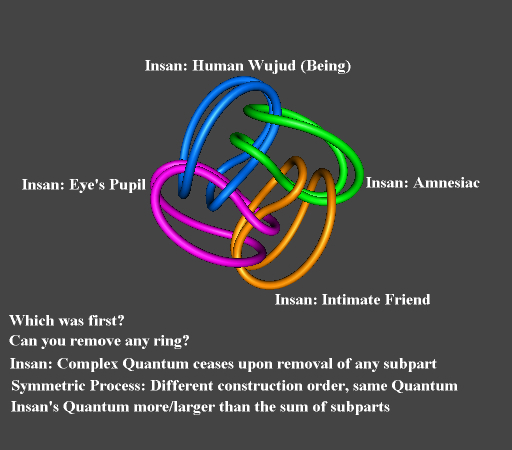
Ibn Al-Manzur Afriqi (Lisan Al-Arab)
"Insan" means human being, people; it also means the pupil of
the eye.
"Ins" is the opposite of the desolate/deserted.
والإِنسانُ أَيضاً: إِنسان العين،
والأَنَسُ: خلاف الوَحْشَةِ،
Ibn Abbas
He was named Insan (Amnesiac) because he had forgotten a covenant (he
was bound to). (Dara: The covenant of professing the Tauhid (Divine
Oneness))
وروي عن ابن عباس، رضي اللَّه عنهما،
أَنه قال: إِنما سمي الإِنسان إِنساناً لأَنه عهد إِليه فَنَسيَ،
Nasafi
“You are a copy of the Eminent-Universe, and whatever is within the
Minor-Universe also is found within the Eminent-Universe and
vice-a-versa—Homomorphism.”
Zubdatul Haqāyiq (The Quintessential Truths) by Azized-Din
Nasafi
There is a homomorphism,
similar patterns, between There and Here, the
spiritual universe and the corporeal, therefore Gehring’s discovery
might have a profound spiritual Kashf (Uncovering):
In the spiritual world, the human being was a spiritual-eye-form
viewing the Nur (Divine Light).
Upon the concrescence of his biological
creation in this universe, his purpose is again to be an eye which
views the Effulgent Divine Beauty, within and without, aided by the
brains, limbs and cognitive faculties.
Q: What is the first thing
people do after their resurrection in the Hereafter?
A: [39:68] The Trumpet will
(just) be sounded, when all that are in the heavens and on earth will
swoon, except such as it will please Allah (to
exempt). Then will a
second one be sounded, when, behold, they will be standing and looking on!
وَنُفِخَ فِي الصُّورِ فَصَعِقَ مَن فِي
السَّمَاوَاتِ وَمَن فِي الْأَرْضِ إِلَّا مَن شَاء اللَّهُ ثُمَّ نُفِخَ
فِيهِ أُخْرَى فَإِذَا هُم قِيَامٌ يَنظُرُونَ
Q: Looking at what?
A: [39:69] And the Earth will
shine with the Glory of its Lord: the Kitab (Record (of Deeds)) will be
placed (open)
وَأَشْرَقَتِ الْأَرْضُ بِنُورِ
رَبِّهَا وَوُضِعَ الْكِتَابُ
Q: What would dwellers of the
Paradise do?
A: Glance at Allah’s Divine
Face.
To those who do right is Husnā - Yea, more (than in measure)!
(Qur'an [10:26]).
Ibn Al-Manzur Afriqi (Lisan Al-Arab)
Husnā means Paradise. The Term ‘more’ is glancing upon the
Allah’s Face from
Husnā (Paradise).
لسان
العرب - لابن المنظور الإفريقي.
حسن:
لِلَّذِينَ أَحْسَنُوا الْحُسْنَى
وَزِيَادَةٌ} [يونس: 26] فالحُسْنى هي الجنّة، والزِّيادة النظر إلى وجه
الله تعالى.
ابن سيده: والحُسْنى هنا الجنّة، وعندي
أَنها المُجازاة الحُسْن
Therefore the primary action of the human being, immediately after the
resurrection from the grave and entering Paradise, is the beholding of
the Divine
Face. By the very application of the homomorphism,
one
can conclude that the primary activity of the human being in this world
is to view the Divine Beauty. And this is in full agreement with
Gehring’s Pax6
discovery: First there was the eye, then came other
faculties and organs only to support the vision’s necessary
post-processing.
Nasafi
“Be cognizant of your own beginning and your own end, that you might
come to know the beginning and the end of the Eminent-Universe”.
Zubdatul Haqāyiq (The Quintessential Truths) by Azized-Din
Nasafi
By carefully studying jellyfish vision and its relationship to our own
vision as it applies to the Pax6 gene, we might become
cognizant of the
other spiritual realm:
[6:38] There is not an animal (that lives) on the earth, nor a being
that flies on its wings, but (forms part of) communities like you. Nothing have we
omitted from the Book, and they (all) shall be gathered to their Lord
in the end.
وَمَا مِن دَآبَّةٍ فِي الأَرْضِ وَلاَ
طَائِرٍ يَطِيرُ بِجَنَاحَيْهِ إِلاَّ أُمَمٌ أَمْثَالُكُم مَّا
فَرَّطْنَا فِي الكِتَابِ مِن شَيْءٍ ثُمَّ إِلَى رَبِّهِمْ يُحْشَرُونَ
Note: ‘like you’ is the Arabic word Amthālukum
which is derived from Mathal and its other derivative Mithāl which
means mold to shape. In other words, we are molded and shaped similarly
to the other animals, and in species similar to each other. Perhaps the
English phrase ‘Similar Design Pattern’ is more suited for Mathal.
لسان العرب ابن
منظور
والمِثال: القالَبُ الذي يقدَّر على مِثْله..
Ibn Al-Manzur Afriqi (Lisan Al-Arab)
Mithal is the form against which what is similar is
measured/compared/decreed. (Dara: Like a mold, shapeless takes shape
from the mold)
Noriyuki Azuma
“Similarity of eyegone and Pax6(+5a) at a
functional level is indicated
by our data showing that overexpression
of human Pax6(+5a) induces
strong overgrowth of retina in the vertebrate eye.”
Source: “The
Pax6 isoform bearing an alternative spliced exon promotes the
development of the neural retinal structure”
In layman language : The introduction of the human eye-gene (Pax6) into
other vertebrates causes extra growth of their retina!
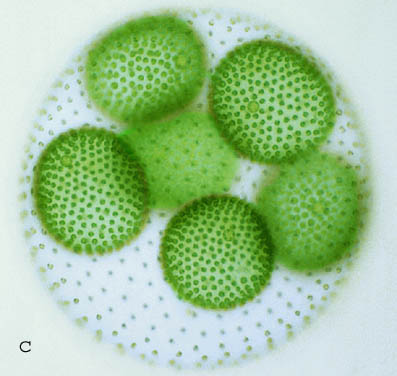
Steirwald (PhD Thesis,
2004)
“All animals/humans (including the eyes of cnidarians) use rhodopsin as
photoreceptor molecule. Opsins
of all animals are probably homologous.”
A photoreceptor molecule found in sea unicellular beings and within the
human eyes—Rhodopsin
as a serialized molecule within the Kitab (Archive
where all the serializations of all objects are stored) from which
nothing was omitted as Allah states; a
common serialization between all
animals and humans, specifically common serialization focused on the
vision.
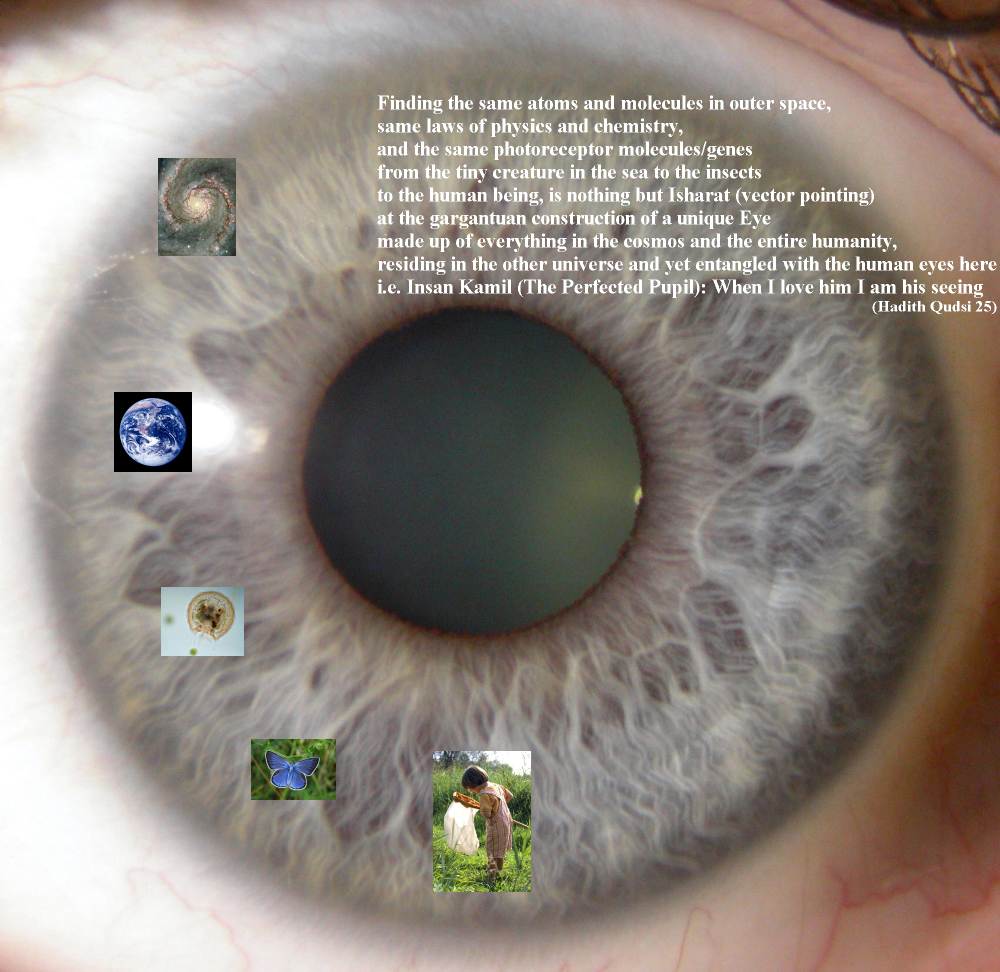
Al-'Absār: The Society, The
Continuum
Ibn ‘Ādil
“Alif-Lam (AL, article THE) has been placed while using the
plural-template for Al-‘Absār (The eyes)—as opposed to the usual
single-form ‘The eye’—and this attributes to the word the sense of
‘Istisrāq (Universal inclusion :containing/ including all eyes).”
تفسير
اللباب في علوم الكتاب/ ابن عادل (ت 880 هـ)
الثالث: أن لَفْظِ " الأبصار " صيغة
جَمْعٍ دَخَلَ عليها الألف واللام، فهي تفيد الاسْتِغْراقِ في قوله: {
تُدْرِكُهُ ٱلأَبْصَارُ }.
Alif-Lam (AL, article THE) makes the collective of all eyes definite ;
without its application we would have understood eyes to refer to a set
of some sort, indicating a collective without any
binding external relationship. However, with the introduction of the
Alif-Lam (AL, article THE) in Al-‘Absār (The eyes) we get an additional
dimension: The collective of all eyes is made definite—in and of
itself—as another separate Wujud (Being) referred
to by the determinate
definite identifier Al-‘Absār (The eyes).
Let’s refer to Al-‘Absār (The eyes) with the English phrase ‘The
Society of eyes’. the society—in and of itself—has an existence with
rules and regulations governing any externally bound society,
independant from the eyes which it contains.
Note: By the term ‘externally bound’, I mean:
there are external reasons/causes/processes that bind the eyes into one
society; by themselves the eyes could not have been made into one such
collective.
A Divine Decision must have been decreed in order for this bond to be
enforced within this world. Without such a Divine Decision, the eyes,
as we view them today, would be just bodily components scattered around
in animals and man.
Q: What binds the eyes into
this Society of the eyes?
A: Harf Bā (B sound):
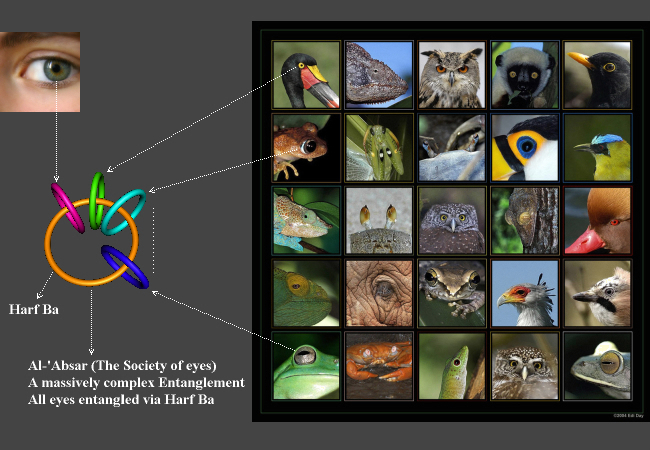
Al-‘Absar (The Society of eyes) entangled with Harf Bā forms a
magnificently complex Quantum. The eyes’ entanglement provide the
attribute of vision for Harf Bā, and
vice-a-versa the eyes are given a
conduit to the other world, all the way back to the Alastu event. The
eyes’ entanglement causes them to be of a unique single nature—as we
can see by the genetics of Pax6—also causes
them to be a marvelously
integrated and shared vision. Somehow an eye that saw something one
thousand years ago, is entangled with your eye that is reading these
odd words.
Al-‘Absār (The Society of eyes) is the plural form of the three letter
Arabic word Basar (To see) which starts with the letter (Harf) Bā (B
sound). Harf Bā was the first prehension
that emanated from the realm
of the souls, as also the first letter of the word Balā (Yes!) which
was the response to the Divine Inquiry: "Aren’t
I your Lord?".
Clue: Careful examination of the pronunciation
of Qur’an—Tajwid—reveals that the Bā of
Al-‘Absār (The Society of eyes)
i.e. the B sound, ought to be pronounced with emphasis on the consonant
B-sound. This emphasis is repeated for the derivations of Basar e.g.
Al-‘Absār, and the emphasis is called Qalqala by the Arabs. Qalqala of
Bā must be
observed in every occurrence of Basar and its derivative
Al-‘Absar (The Society of eyes) as a reminding clue to remember the
importance of the Harf Bā.
Al-‘Absar (The Society of eyes) has two noteworthy attributes:
1. Continuity: The potential to express genes and the
potential for mutations provide the necessary potential for
divisibility for eyes/vision. Therefore it is quite obvious to observe
so many different variations of eyes, for the society of the eyes is
prone to divisibility and therefore continuity as its attribute.
2. Extensiveness: As genes and their mutations
allow
for the extensiveness of the molecular extensions to the eyes, the
corporeal eyes are extended into the spiritual realm and finally into
the world after.
This extensive continuity is called continuum. Al-‘Absar (The Society
of eyes) is a continuum extending from the corporeal eye/vision to the
spiritual eye/vision, from the eye/vision of this world to the
eye/vision of the world after.
Note: The collective of the eyes is divided e.g.
the complex eye of the fly and the camera-eye of the human being. Now
when I say divisible' it is meant that there is potentiality for
objectification of something new, in the sense of: If I can count one
and I can count 0 then I can count ½, and if I can count
½ and 0,1 then I can count ¼ and so on. Although I may
never count anything yet there is the potential possibility that I may
count 1/8! This is called divisibility. As for the eyes, mutations are
what make the eyes divisible, one can mutate infinitely many new types
of eyes, though none may actually occur in the nature but the potential
for the new mutation is there in all time and in all space and for all
eyes, therefore the society of the eyes is divisible. Eye colors are a
good example, there is infinitely many potential possibilities for the
eye colors, however few are realized. So between the black eye and
almost white eye, one can get many shades of eye colors.
Darwin
Charles Darwin in “The Origin of Species” had great difficulties with
eye evolution and devoted an entire chapter to “Difficulties of the
Theory” in which he discusses “Organs of extreme Perfection and
Complication”:
“To suppose that the eye with all its inimitable contrivances for
adjusting the focus to different distances, for admitting different
amounts of light and for the correction of spherical and chromatic
aberration, could have been formed by natural selection, seems,
I freely confess, absurd in the highest degree”.
But then he continues:
“Reason tells me, that if numerous gradations from a
simple and imperfect eye to one complex and perfect can be
shown to exist, each grade being useful to its possessor, as is
certainly the case; if further, the eye ever varies and the variations
be inherited, as is likewise certainly the case; and if such variations
should be useful to any animal under changing conditions of
life, then the difficulty of believing that a perfect and complex eye
could be formed by natural selection, though insuperable by our
imagination, should not be considered as subversive of the
theory”.
What is lacking in Darwin’s vision is the concept of an extensive
continuum or the society concept of the eyes. He was only able to
render this thoughts in terms of evolutionary processes, and missed on
the ‘unobservable’ or the spiritual aspect of the eye development.Once
the concept of Al-‘Absar (The Society of eyes) is understood as an
extensive continuum and a massively complex Quantum, one can easily see
how the difficulties of his theory may be resolved:
1. Continuum: Why are there so many eyes?
2. Extensive: Why is there such variety of eyes?
3. Society: A common ancestor!
Note: For spiritual people, the approach to the theory of evolution and
the current scientific understanding of the development of organisms is
beyond the creationist versus
evolutionist debate. The
concept of Al-‘Absar (The Society of eyes) takes advantage of
laboratory data, human theories e.g. Darwin’s as well as deep Gnosis
(Ma'rifa) within the individual without the‘us vs. them'
mentality. In Sufism particularly, ignoring the vast laboratory data on
matters such as eye development is only an impediment to the Path and
an exit from the Voyage.
Hu’s perpetual Prehension of all eyes
[6:103] Al-’Absar (The eyes, single) does not grasp/prehend
Hu
(IT, He)
while Hu (IT, He) prehends Al-‘Absar (The eyes, single).
I checked all the Tafasir (Exegeses) of this Ayat ranging from the
Sunni/Salafi to Shiites to Sufis, basically all state the same thing:
"Eyes cannot see Allah
but Allah can see eyes!"
However, using the word prehend in
place of the Arabic word Dark
(Grasp) we find amazing new meanings as follows.
‘Al-’Absar (The eyes, single) does
not grasp/prehend
Hu’
is the wrong translation. The correct
translation should read: Al-’Absar (The eyes, single) NEGATIVELY
prehends Hu! Because if something cannot prehend The Creator/Hu
then it
cannot exist since the prehension
of the Creator is what makes
something a creation!
‘Al-’Absar (The eyes, single) negatively prehends Hu’:
1. Zajāj: Hu’s
creatures are not cognizant of the
Haqiqa (Reality, Truth) of the eyes, and what made the human being to
become seer, what made his eyes to see while the rest of his limbs
cannot. Know that none of Hu’s
creatures can fully grasp the reality of
the other creatures, let alone the Reality of Allah.
وفي التنزيل العزيز:
لا تدركه الأَبصارُ وهو يدرك الأَبصارَ؛ قال أَبو إسحق: أَعْلَمَ اللهُ
أَنهُ يُدْرِك الأَبصارَ وفي هذا الإِعلام دليل أَن خلقه لا يدركون
الأَبصارَ أَي لا يعرفون كيف حقيقة البَصَرَ وما الشيء الذي به صار
الإِنسان يُبْصِرُ من عينيه دون أَن يُبْصِرَ من غيرهما من سائر أَعضائه،
فَأَعْلَم أَن خَلْقاً من خلقه لا يُدْرِك المخلوقون كُنْهَهُ ولا يُحيطون
بعلمه، فكيف به تعالى والأَبصار لا تحيط به وهو اللطيف الخبير.
2. The Divinity veiled ITSELF so that the eyes cannot see a
Divine Being,
or the Divine Presence. Because of this deeply innate
veil, the society as one whole being is veiled by its nature and needs
Kashf (Unveiling) to see spirituality and Divine Secrets.
3. Not all what the creatures are able to see is Hu!
4. Negative prehension
causes the simplicity of eyes’
perception i.e. had this negative prehension not been there, no brain
of any creature would have been able to process the infinite data
entering the eyes! Spiritual or corporeal! Only thus are the eyes able
to see the simplified images of Hu’s
handicrafts.
5. Had this negative prehension
not been there, we
could not even understand the very concept of "eye" itself! Indeed the
complexities of the creation of the corporeal eye and the spiritual eye
are masked
vis-à-vis the negative Prehension.
The simple concept of ‘eye’ and ‘seeing’ are made simple
vis-à-vis this negative prehension, these are creations of Hu
such that without this negative prehension, without this mask/veil, no
intellect in the universe could have ever grasped either ‘eye’ or
‘seeing’.
6. Hu is
a blazing source of Tajalli (Lucent
Manifestation); had there been no negative prehension,
all eyes would
have been blinded!
7. The negative prehension
indicates that there is no
room for multiple eyes, as an ensemble as a collective of many eyes
there is no way to view Hu!
This subjective-form of negative prehension
is the visual-feel for Tauhid (Divine Oneness).
‘Hu
(IT, He) prehends
Al-‘Absar (The eyes, single)’:
Q: What does ‘Hu
prehends’ mean?
A:
1. Hu
molds/configures/regenerates the society of
eyes as well as individually
2. Images formed within each eye reach Hu
i.e. Hu
sees them
3. The subjective-form of Hu’s prehension
of the eyes
is the Divine Presence!
4. Hu’s
prehension of the society of the eyes means
every eye ever, and ever eye that will be, corporeal or spiritual, are
all entangled with this Divine Presence. Remember not commixed since
there is no immixing with the Divine Presence and Attributes.
5. The Subjective-form of the Hu’s prehension
of the
society of the eyes is also Hu’s Tajalli (Lucent
Manifestation) that
glows, perpetually, and this glow allows the eyes to see!
6. Hu prehending
the eyes as a unit society means,
the subjective-form of this prehension
causes all eyes to approach the
Tauhid (Divine
Oneness)—as One Eye!
Grammatical issues pertaining to the Ayat:
1. Wa: Usually in Arabic means ‘and’, however, here
it is Hāliya (Being in a state of some sort) or in English ‘while…’
2. Both verbs of Dark are conjugated
in the present/future tense. In the Arabic of the Qur’an, this
indicates perpetuity within which there is continual refreshing. That
is, these prehensions,
positive or negative, are constantly being
refreshed or prehended.
Metaphysical Tarkib (Composition)
[6:103] Al-’Absar (The eyes, single) negatively prehends
Hu (IT,
He)
while Hu (IT, He) prehends Al-‘Absar (The eyes, single):
Lets P- = Al-’Absar (The eyes, single) negatively prehends
Hu (IT,
He)
Lets P+ = Hu (IT, He)
prehends
Al-‘Absar (The eyes, single)
Lets | = Wa-Hāliya i.e. ‘while’
The verse can be re-written as:
P- | P+ = A repeated negative prehension
while a repeated
positive prehension prehending
Or a negative prehension
nested within a perpetual positive prehension,
where the negative indicates absence (Absent from this observable
world: Latif) and positive indicates presence (Informed while in the
other world: Khabir).
Imam Al-Ghazali
Latif (Subtle)
Only the entity that knows the intricacies of affairs (beneficial to
others) and their innate complexities deserves this name. One who is
able to deal with the concealed intricacies and yet be subtle i.e.
transparent; deliver to the needy in need, and do so with friendship
exempt from all enmity—Al-Latif (The Subtle).
When friendliness of the deeds and subtlety/transparency in knowledge
are integrated together the meaning of Latif is completed.
Example of being Latif is the fetus being nursed and preserved in the
darkness of the womb, delivered with nutrients through the umbilical
cord, and yet eating through the mouth following birth , etc...
Dara: From the subdivision of the cells to the
transcription/translation of the DNA into proteins;, from the gene
enhancers to inhibitors switching on/off the production of the proteins
and cell development, to the nerve muscle and bone development,
friendly procedures of a master skillful innovative engineer are at
work and yet all we see are atoms, molecules and tissues; we cannot
directly see the engineer designing and orchestrating all this. Only
SUBTLY do we understand that there is more to this than meet the
eyes.
Imam Al-Ghazali
Khabir (Informed)
Hu,
is Al-Ladhi (That
Which), is not far from the information about the
inmost concealed core of all objects (Batin); nothing moves around Hu’s
spiritual or corporeal realms and no Nafs (Self)
becomes anxious or
tranquil without Hu being informed thereof —Al-Khabir (The Informed).
Essentially Khabir means the knower, however if it is the knowing that
is about the inmost (Batin) cores of objects which is called Khabar and
the knower of that Khabar is called Kahbir.
Dara: I do not know what images are formed on the retina of your eyes
and what your mind has processed of the signals of neurons; neither do
I know the reaction of your heart and Nafs (Self)
with regards to what
you have seen. So I do not have information about the inmost parts of
your eyes and heart, but Allah has this
information; that is the
reason why, Allah’s special attribute of knowing is called Khabir.
Now the verse [6:103] is followed by the fact that Hu (IT, He)
is the
Latif (Subtle) and the Khabir (Informed about the inmost core of all
objects):
Ibn ‘Ajiba
[6:103] Al-’Absar (The eyes, single) does not prehend Hu
(IT, He)
while
Hu (IT, He) prehends Al-‘Absar (The eyes, single) and Hu (is) Al-Latif
(Subtle) Al-Khabir (Informed, Knower):
“Al-’Absar (The eyes, single) does not prehend Hu”
corresponds to “Hu
(is) Al-Latif (Subtle)”; “Hu (IT, He) prehends Al-‘Absar (The eyes,
single)” corresponds to “Hu (is) Al-Khabir (Informed, Knower)”; and
these two correspondences are due to the Al-Laff (Involution, Coiling,
Twisting, Folding)—a form of creative syntactic composition in
classical Arabic.
تفسير البحر المديد
في تفسير القران المجيد/ ابن عجيبة (ت 1266 هـ)
ثم قال تعالى: { وهو يُدرك الأبصارَ } أي: يحيط علمه بها؛ إذ لا تخفى عليه
خافية، { وهو اللطيف الخبير } فيدرك ما لا تدركه الأبصار،
ويجوز أن يكون تعليلاً للحُكمَين السابقين على طريق اللفّ، أي: لا
تدركه الأبصار لأنه اللطيف، وهو يدرك الأبصار لأنه الخبير،
فيكون اللطيف مقابلاً للكثيف، لا يُدرك بالحاسة ولا ينطبع فيها.
قاله البيضاوي وأبو السعود.
الإتقان في علوم
القرآن السيوطي
اللف والنشر: هوأن يذكر شيئان أوأشياء، إما تفصيلاً بالنص على كل واحد،
أوإجمالاً بأن يؤتى بلفظ يشتمل على متعدد ثم يذكر أشياء على عدد ذلك، كل
واحد يرجع إلى واحد من المتقدم، ويفوض إلى عقل السامع رد كل واحد إلى ما
يليق به، فالإجمالي كقوله تعالى وقالوا لن يدخل الجنة إلا من كان هوداً
أونصارى أي وقالت اليهود لن يدخل الجنة إلا اليهود وقالت النصارى لن يدخل
الجنة إلا النصارى، والتفصيلي قسمان: أحدهما أن يكون على ترتيب اللف
كقوله تعالى جعل لكم الليل والنهار لتسكنوا فيه ولتبتغوا من فضله فالسكون
راجع إلى الليل والابتغاء راجع إلى النهار.: وذكر الزمخشري له قسماً آخر
كقوله تعالى ومن آياته منامكم بالليل والنهار وابتغاؤكم من فضله قال: هذا
من باب اللف، وتقديره ومن آياته منامكم وابتغاؤكم من فضله بالليل والنهار،
إلا أنه فصل بين منامكم وابتغاؤكم بالليل والنهار لأنهما زمانان، والزمان
والواقع فيه كشيء واحد مع إقامة اللف على الاتحاد
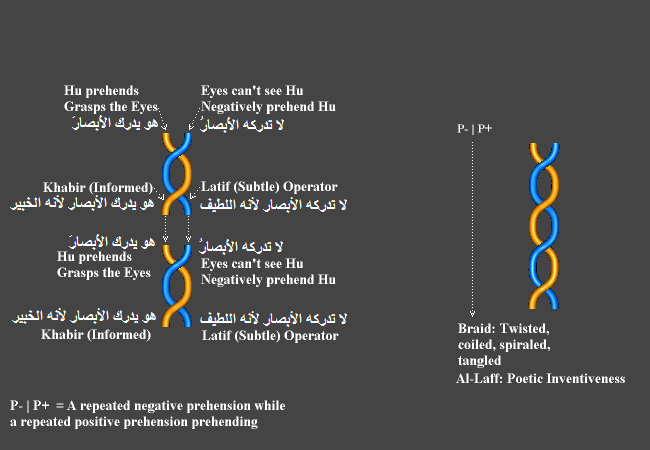
Q: Why could the threads ends
not be just straight down avoiding the braids’ entanglement?
A: Because the two statements:
"Hu
prehends
all eyes & Eyes negatively prehend Hu" are entangled
i.e. inseparable, inexorably linked and yet not touching in any form or
fashion; the braids’ twist guarantees this entanglement.
Topology of Basira (Spiritual Eye):
Braids!
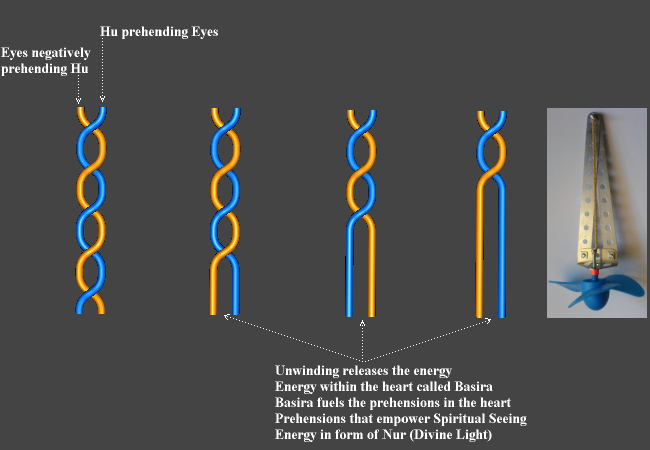 “[6:103] No
eyes grasp Hu
while Hu grasps/prehends
all eyes” forms a braid through
its topology. Or you might say the Basira, the energy that fuels the
prehensions
within the heart and enables them to see spiritually, is
stored infinitely and indefinitely within the powerful twists and
tangles of the braids:
“[6:103] No
eyes grasp Hu
while Hu grasps/prehends
all eyes” forms a braid through
its topology. Or you might say the Basira, the energy that fuels the
prehensions
within the heart and enables them to see spiritually, is
stored infinitely and indefinitely within the powerful twists and
tangles of the braids:
Ibn Kathir
“[6:103] No eyes grasp Hu
while Hu grasp/prehend
all eyes: This is with
regards to Hu’s (ITs, His) Nur (Divine Light):
when Hu makes Tajalli
(Lucent
Manifestation) with Hu’s Nur, no object can grasp/prehend Hu!
(or withstand Hu).”
From this exegesis, we can obtain a clue: Unwinding the Braid allows
for negative prehensions
of Eyes while Hu
positively prehends
Eyes, thus Nur
(Divine
Light) emanated for the viewer to see with; had there been only one
prehension then there would have been no way to primordially store
energy/Nur and no way to release it via unwinding—thus both negative
and positive prehensions necessary. . This
is similar to the
unwinding of a rubber propeller which releases the stored energy.
Without this unwinding, there would be no release of energy, no Nur, no
Basira to see with.
Note: The term Unwinding is Nashr in Arabic and
is used alongside the term Laff (Twisting, Tangling).
تفسير تفسير القران الكريم/ ابن كثير (ت
774 هـ)
وقال آخرون في الآية بما رواه الترمذي
في جامعه، وابن أبي عاصم في كتاب السنة له، وابن أبي حاتم في تفسيره،
وابن مردويه أيضاً، والحاكم في
مستدركه، من حديث الحكم بن أبان، قال: سمعت عكرمة يقول: سمعت ابن عباس
يقول: رأى محمد ربه تبارك وتعالى، فقلت: أليس الله يقول: { لاَّ
تُدْرِكُهُ ٱلأَبْصَـٰرُ وَهُوَ يُدْرِكُ ٱلأَبْصَـٰرَ } الآية، فقال لي:
لا أم لك، ذلك نوره، الذي هو نوره، إذا تجلى بنوره لا يدركه شيء
A very odd discovery is that, the very engine that heats our sun’s
corona consists of magnetic twisted braids which release energy in the
form of heat radiation as they unwind into simpler field lines:
Dawn Lenz
Theories of how flares and CMEs
develop and erupt, the conditions in
the solar atmosphere required for the generation of such phenomena, and
the mechanisms by which the energy is expelled and the particle flux is
propelled outward into interplanetary space are areas of active
investigation in solar physics. The foundation of almost all such
theories involves the twisting and tangling of magnetic-field
lines in
the solar atmosphere as a result of the underlying fluid motions in the
convective layer just beneath the solar photosphere. According to the
theory of magnetic reconnection, developed by Eugene Parker of the
University of Chicago and Peter Sweet of the University of Glasgow
(Scotland) in the 1950s, solar
magnetic-field lines progressively become more chaotically intertwined,
increasing the stresses between them. When the stresses become severe
enough, the field lines reconnect with an associated release of energy.
Source: Understanding
and predicting space weather
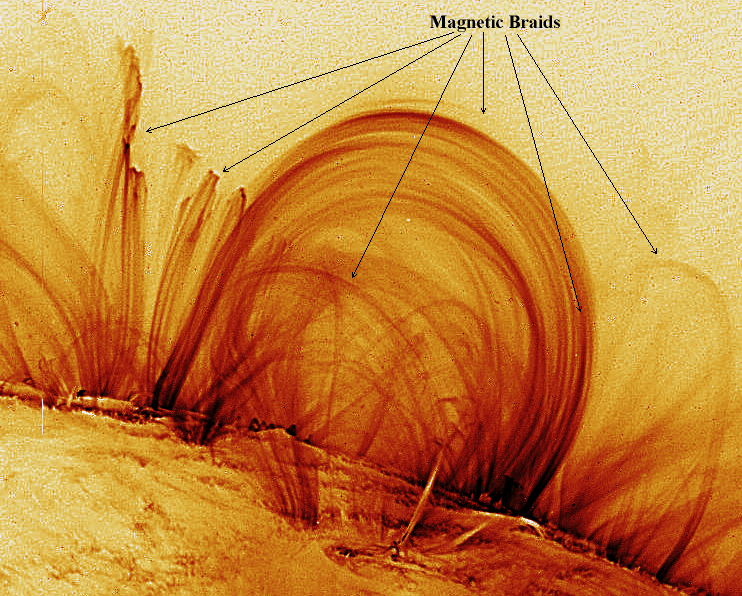
Images at extreme-ultraviolet and X-ray wavelengths have shown that the
hottest and densest material in the low corona is concentrated in
magnetic loops. Indeed, Yohkoh’s soft X-ray images have demonstrated
that the entire corona is stitched together by thin, bright, magnetized
loops that shape, mold and constrain the million-degree gas. Wherever
the magnetism in these coronal loops is strongest, the coronal gas in
them shines brightly at soft X-ray wavelengths.
High-resolution TRACE images at the Fe IX, Fe XII and Fe XV lines,
respectively formed at 1.0, 1.5 and 2.0 million degrees, have
demonstrated that there is a great deal of fine structure in the
coronal loops. They have pointed toward a corona comprised of thin
loops that are naturally dynamic and continually evolving. These very
thin loops are heated in their legs on a time span of minutes to tens
of minutes, after which the heating stops or changes, suggesting the
injection of hot material from somewhere near the loop footpoints in
the photosphere or below. The erratic changes in the rate of heating
forces the loops to continuously change their internal structure.
Magnetic loops can heat the corona in another way – by coming together
and releasing stored magnetic energy when they make contact in the
corona. Internal motions twist and stretch the magnetic fields, slowly
building up their energy. When these magnetic fields are pressed
together in the corona, they merge, join and self destruct at the place
where they touch, releasing their pent-up energy to heat the gas.
The SOHO spacecraft has provided direct evidence for such a transfer of
magnetic energy from the solar photosphere into the low corona. Images
of the photosphere’s magnetism, taken with SOHO, reveal tens of
thousands of pairs of opposite magnetic polarity, each joined by a
magnetic arch that rises above them. They form a complex, tangled web
of magnetic fields low in the corona, dubbed the magnetic carpet. The
small magnetic loops rise up out of the photosphere and then disappear
within hours or days. But they are continuously replenished by the
emergence of new magnetic loops, rising up to form new magnetic
connections all the time and all over the Sun.
The magnetic interaction of coronal magnetic loops, driven together by
underlying convective motions, also energizes at least some of the
bright “points” found in X-ray images of the Sun. Unlike sunspots and
active regions, the X-ray bright “points” are uniformly distributed
over the Sun, appearing at the poles and in coronal holes, some almost
as large as the Earth.
Source: The
magnetic solar atmosphere

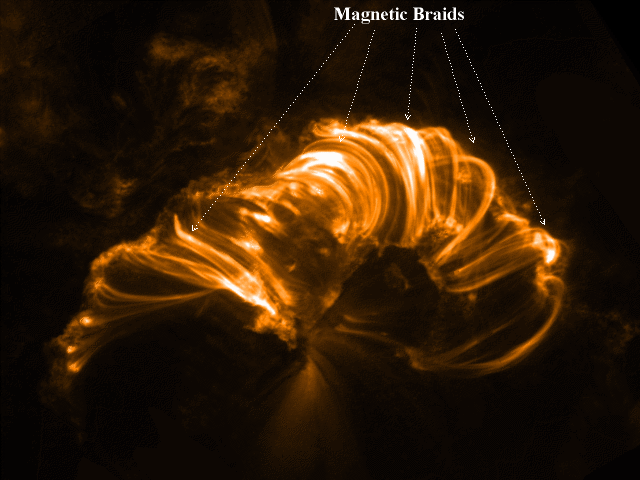
Cell Motility and Spiritual Voyage
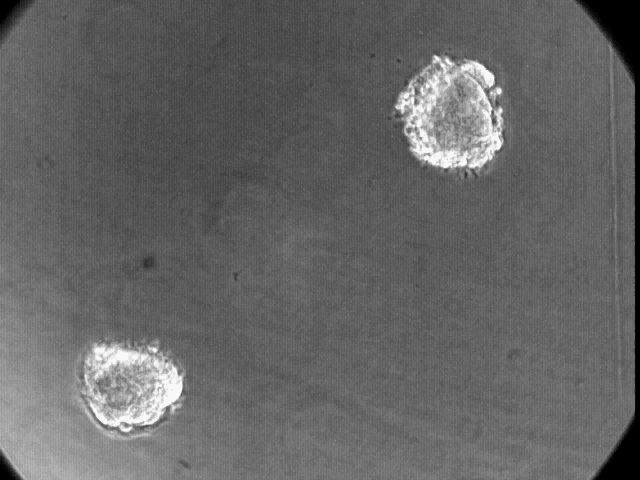
Robert Weinberg
“Although each cell carries an extraordinary elaborate data bank in its
genes, these genes
cannot provide the cell with some very critical
pieces of information. Genes cannot tell a cell where it is in the
body, how it arrived there, or whether the body requires it to grow.
Genes can only tell the cell how it should respond to external signals,
which must come from elsewhere—from other cells, nearby or distance in
the body.”
Source: One
Renegade Cell , Chapter 10: Guide Proteins
Basically the cell, if it could speak, would ask:
Q: Where in the body was I
duplicated?
Q: In which organ am I now?
Q: How did my genetic switches
turn on?
Q: Which genes am I to express?
Based on Nasafi’s Homomorphism—precisely
the above statements do apply
not only to cells, but also to human spirituality, in spite of our
complex minds and hearts:
Q: Where have I come from?
Q: Where am I now?
Q: How did I get here?
Q: Who am I?
None of this information is readily available since the Insan (Human
Being) is an
amnesiac as well; the information is wiped from both the
corporeal and the spiritual memory.
Note: So you know what Dhikr (Remembrance)
is
all about, don't you?
Sally Moody
“It is well known that many embryonic cells do not simply stay in their
place and passively respond to whatever signals waft
their way. During
gastrulation MANY CELLS MOVE GREAT DISTANCES, or simply rearrange or
reorder themselves, which provides them the opportunity to interact
with new neighbors and new signaling-environments. We recently found
out that this cellular reorganizing makes embryonic cells competent to
become retinal. Our studies were done on Xenopus… But most interesting,
not every Pax6
expressing cell became retinal! Only those that had
moved into the eye competent domain!”
Source: To
Differentiate or Not to Differentiate, Landes Bioscience, May 2004.
Apply Nasafi’s Homomorphism:
The Insan suffering from amnesia has no faculty or ability or data to
answer the above questions! In order for him/her to be able to find
clues for the answers s/he must voyage i.e. Suluk (Voyage).
Just like
the cells which are supposed to become eyes and yet they have been left
dormant around the abdomen, they need to move towards the visual zone
to be able to express their genes
and produce eyes!
Similarly, in order to develop Basira (Spiritual Eye) to see the
spiritual reality, the human being, like the cells, must travel from
where s/he is now to another location where the Basira can empower the
heart to see the Nur (Divine Light).
For more detailed discussion on this spiritual voyage please see the
Papillon.
Eye Loss

Carl Zimmer
"Cavefish were familiar to Darwin, as were the many other blind cave
dwellers, such as salamanders and insects. Darwin saw cavefish as yet
another example of an animal carrying around the vestiges of its
ancestors, just as we carry around the stump of a tail. As for how
cavefish lost their eyes, he set natural selection aside. Darwin could
not imagine how a fish in a cave would get any benefit from eyes that
did a worse job than its ancestors' eyes. "I attribute their loss soley
to disuse," he wrote. By disuse, Darwin may well have been thinking
along the lines of his precursor, Lamarck. As fish stopped relying on
their eyes in the dark, somehow their eyes degenerated, and that
degeneration was passed down to the next generation of fish.
Jeffery and his colleagues have also tracked the degeneration of the
eye at the level of genes.
The neutral mutation hypothesis would lead
you to expect that cave fish would express fewer genes in the eye than
surface fish, because many of them would have been destroyed by
mutations. But this is not the case, Jeffery and his colleagues have
found. Instead, they're starting to identify some genes that make more
of their proteins in the eyes of cave fish than in those of surface
fish, and even some genes that aren't active in the eyes of surface
fish at all.
One particularly important protein in the developpment of cavefish eyes
is known as Hedgehog. In all vertebrates, Hedgehog plays a vital role
in the development of the eye, starting at its earliest stage.
Initially, the cells that will give rise to the eyes form a single
cluster. Cells in the midline of the embryo start producing Hedgehog,
which somehow signal the cells in the middle of this eye cluster to
stop developing. As a result, only the cells on the far sides continue
to develop, thus producing two separate eyes. Mutations that interfere
with the production of Hedgehog can cause a gruesome birth defect in
humans called cyclopia, in which a single cyclops-like eye develops.
Cave fish have evolved in the opposite direction: they produce more
Hedgehog, rather than less. The extra protein stops the development of
a wider expanse of the original eye-cell cluster, leaving few cells to
progress. Jeffery and his colleagues confirmed this by boosting the
production of Hedgehog in surface Astyanax. Not only do they develop
smaller eyes, but they suffer the same lens-directed degeneration seen
in cavefish. This means that the degeneration of cavefish eyes requires
cells beyond the eyes to help coordinate the process.
What's most remarkable about this choreography is that it has evolved
again and again. Studies on Astyanax DNA suggest that populations of
surface fish have repeatedly invaded caves, and each time they have
gone blind. Jeffery and his colleagues have started comparing the
development of embryos from different populations, and they find the
cavefish have evolved blindness through the same patterns of gene
activity.
This parallel evolution is hardly what you'd expect from a random blast
of neutral mutations.
...you wouldn't expect the fish to keep producing new eye cells, even
as the eye begins to deteriorate. Even the degeneration of the eye
challenges both of these hypotheses. The eye doesn't collapse into a
stew of chaos; it is dismantled in a stately choreography. The cells in
the lens release some signal that instructs other eye cells to begin to
commit suicide. In surface fish, the lens sends signals that do just
the opposite, allowing the eye to develop fully. Jeffery and his
colleagues found that if they transplanted just the lens of a surface
fish into the eye of a cave fish, the cave fish grew a completely
normal eye. What's more, the transplant triggered new nerve fibers to
project from the retina to the brain, and the part of the cave fish's
brain that handles vision even grew. It's possible that a transplanted
lens allows a cave fish to see. Despite being blind, the cavefish still
retains its original circuit of eye-building genes."
Source: Eyes,
Part Two: Fleas, Fish, and the Careful Art of Deconstruction
Clue: Cavefish did not lose their eyes due to
lack of usage or due to lack of something, on the contrary the lack of
eyes is due to an overdose/over-expression of
a certain gene in the
body.
The human being does not lose the spiritual eye due to lack of
something in his behavior or knowledge or activity, the spiritual eye
is lost due to overexposure to the Nafs (Self).
Here againg Nasafi’s
Homomorphism is
at work; you cannot get rid of what Allah bestowed
upon
you, as the cavefish cannot get rid of its eyes, but you can and do
often overexpose your Wujud (Being) to the
Nafs (Self)
and this Nafs is
the one and only veil that can block the Nur (Divine Light).
Qushairi
“[20:125]And we shall resurrect him on the Day of Judgment and he will
for certain ask: O my Lord why have you resurrected me blind and yet I
used to be a seer?”: It is found in the narrations (can’t find it from
the Prophet) that ‘Whatever state a person was in this world, will be
his state when he meets Allah in other
world’ i.e. if he was blind in this world not being able to see the Nur
(Divine
Light) for sure he will be again blind in the other world not being
able to see Allah!
Like the person who was ignorant in this world will ask: ‘[36:52]Who
resurrected us from our sleep?’ (Dara: for it is obvious that Hu
resurrected them!)
تفسير لطائف الإشارات / القشيري (ت 465
هـ)
قوله جلّ ذكره: { وَنَحْشُرُهُ يَومَ
القِيَامَةِ أَعْمَى قَالَ رَبِّ لِمَ حَشَرْتَنِى أَعْمَى وَقَدْ كُنتُ
بَصِيراً قَالَ كَذَلِكَ أَتَتْكَ ءَايَاتُنَا فَنَسِيتَهَا وَكَذَلِكَ
اليَوْمَ تُنسَى }.
في الخبر: " مَنْ كان بحالةٍ لَقِيَ اللَّهِ بها " فَمَنْ كان في الدنيا
أعمى القلب يُحْشَرُ على حالته، ومَنْ يَعِشْ على جهلٍ يحشر على جهلٍ،
ولذا يقولون:
{ مَنْ بَعَثَنَا مِن مَرْقَدِنَا }
Man for sure will ask Allah: What
happened to me, I used to be a seer i.e. the primordial state of my
Wujud (Being-ness)
was that of a seer so what happened to my vision? What took it away?
The answer is: Over-exposure to the Nafs (Self)
caused you to forget Allah and Allah’s signs and words, and therefore
today be forgotten! To be given eyes! [20:126].
You have been created to see, and all the other limbs and faculties are
to help and post-process the seeing, but be aware that too much of Nafs
(Self)
causes the blindness and forgetfulness and this state will be carried
to the other universe, in presence of Allah you will
be blind.
Born Blind
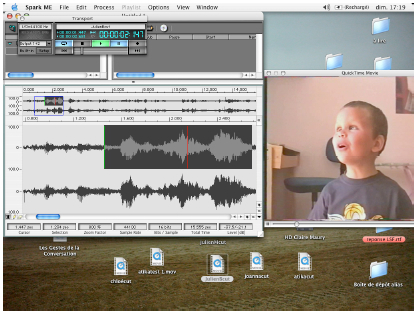
Maury-Rouan
"In a 1998 study based on a group of 6 congenitally blind children and
investigating coverbal
facial expressions in blind subjects, Maury-Rouan found a high
frequency of co-verbal
eyebrow movements (1998). The presence of these eyebrow movements that
seemed to
parallel speech in the same way they parallel sighted speakers
utterances was quite
unexpected, as eyebrow raisings cannot be heard (while smiles other
facial expressions
influence the quality of the voice); therefore they cannot have been
learned from imitation of
a model in the case of blind children. As for the way eyebrow
movements, such as brow
raisings or frowning participate in communication, their general
functions were thoroughly
described and analyzed by Ekman ‘s 1979 study “About Brows”.
The use of such gestures, operating as highlighters as they focus on
one point or part
of the utterance, indicates that the speaker takes a meta-pragmatic
perspective over discourse
as a whole. The fact that blind children might resort to frequent
eyebrow raisings while
speaking (a movement they could not have learned from a visual model,
and although they
could not have experienced the effect it may have on recipients) raises
the same issues as the
iconic gestures, produced by the children studied by Iverson &
Goldin-Meadow, did: if blind
children use them, it means
that, generally speaking, such gestures should be considered as
serving an important function
for the speaker, independently from their effect on listeners."
Source: Maury-Rouan:
Eyebrow raisings: the case of children blind from birth (.pdf)
If the human eyes are removed from the very beginning of fetal-life,
and as a result, the person has no concept of what 'seeing' and 'being
seen' are like, nor of the geometry of the listener's face, nor of the
face’s continuous motion and gestures, then how can the born-blind have
facial gestures, which can only be learned by seeing, and use them
properly during a conversation, as the born-blind do?
‘[6:103] The Eyes negatively prehend Hu’,
although it is a
negative prehension,
yet it has the residual feeling of a
subjective-form i.e. though the eyes cannot see Hu, THEY FEEL THAT THEY
ARE BEING WATCHED! And it is from this innate subjective-form that the
usage of the facial gestures, which otherwise cannot be explained, is
derived!
Remember, that the Nur (Divine Light)
shone within the darkness of
‘Adam (Non-being) and whoever was exposed to this wonderful creative
light came to be i.e. was objectified. But mostly we always forget,
this Nur (Divine
Light) ITself is a SEER! It is a unique form of light
that not only shines upon objects but also itself can see!
And if this light is the very primeval core of human creation, then it
is not hard to assume that we are exposed and thus have been created by
a Divine
Light, and by a Divine Seer, so that, the core of our Wujud
(Being) is a
seer as well! In other words, remove all the cells within
the human body that constitutes the corporeal act of seeing, the
born-blind still makes facial gestures when talking! The blind or the
non-blind human being is first and foremost an eye.
The Mystic Lexicon
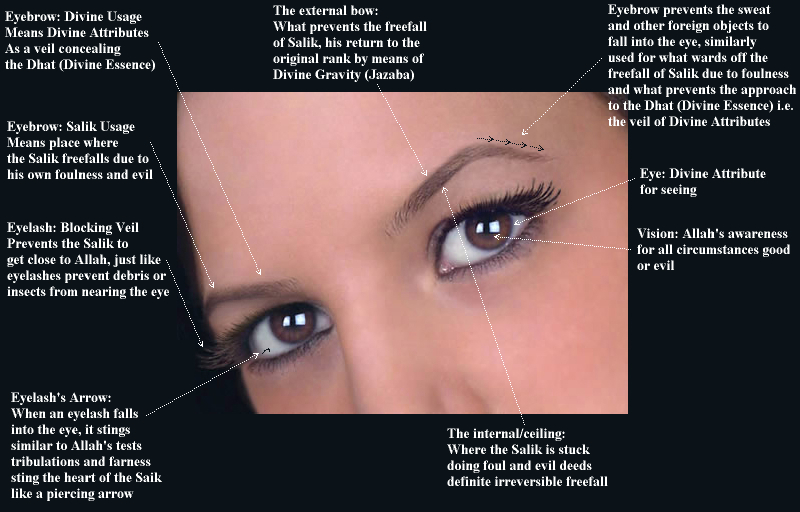
Note: Verbatim from the back of Fakhr-al-Din
Araqi’s Divan:
Abrū (Eyebrow)
ابرو
The eyebrow prevents the sweat and other foreign objects from falling
into the eye, similarly used to refer to whatever wards off the
freefall of the Salik (Voyager) due
to foulness and to what prevents the approach
from the Dhat (Divine Essence) i.e. the veil of Divine Attributes.
Divine Usage:
Means Divine Attributes as a veil concealing the Dhat (Divine Essence).
Salik Usage:
Means place where the Salik (Voyager)
freefalls due to his own foulness and evil.
Kamān-e Abrū (The External Bow
of the Eyebrow)
کمان ابرو
What prevents the freefall of the Salik (Voyager),
his return to the original
rank by means of Divine Gravity (Jadhibiat).
Tāq-e Abrū (The Internal
Ceiling of the Eyebrow)
طاق ابرو
Where the Salik (Voyager) is
stuck doing foul and evil deeds i.e. definite
irreversible freefall.
Muž-eh (Eyelash)
مژه
Blocking veil that prevents the Salik (Voyager)
from getting close to Allah, just
like eyelashes prevent debris or insects from nearing the eye.
Tir-e Muž-eh (Eyelash’s Arrow)
تیر مژه
When an eyelash falls into the eye, it stings similar to Allah’s tests
tribulations and ITS/HIS farness sting the heart of the Salik (Voyager)
like a
piercing arrow.
Chashm (Eye)
چشم
Divine Attribute of seeing.
Did-eh (Vision)
دیده
Allah’s
awareness of all circumstances good or evil.
Chashm-e Mast (Drunken Eye)
چشم مست
The state wherein Allah
conceals the Salik’s faults, from him and from
others; he is forgiven and no one is able to see his faults.
Chashm-e Khumār (Drowsy Eye)
چشم خمار
The state wherein Allah
conceals the Salik’s faults, though the sages
who have reached Kamal (Perfection)
can see his faults; at times, they
point out some of what they see, and at other times they remain silent.
Chashm-e Āhūvān-e (Defective
Eye)
چشم آهوانه
The state wherein Allah
conceals the Salik’s faults from all else
except his own Self,
in order for him to attend to his shortcomings.
(Dara: Āhū normally means deer in Farsi, however, it also has the
rarely used meaning of being defective or ill! Allah makes all
other
eyes defective so that, they do not to see the Salik’s fault: Allah
sends an illness to all other eyes to make them unable to see the
Salik’s faults!)
Chashm-e Shahlā (Exotically
Beautiful Black Eye)
چشم شهلا
Manifesting the lofty superior state of the Salik (Voyager), to
be seen by his
own Self
and to be witnessed by others, the very source of his fame—not
by his own marketing effort—empty from all deception.
Chashm-e Tark (Forsaken Eye)
چشم ترک
Allah’s
concealment of the Salik’s lofty states and perfections; his
loftiness is not known to his own Self
nor witnessed by others; this is
the perfection of being concealed by Allah.
Chashm-e Narges (The Eye of
Daffodil)
چشم نرگس
Allah’s
concealment of the Salik's lofty states and perfection,
though seen by the people as a Wali (Friend of Allah), yet he himself
is unaware of this and does not see his great states; or it is the
reverse,
where he himself knows of his lofty state and sees himself in such a
state whereas others cannot. The two types belong to the same
category.
Gisū (Strand of Hair)
گیسو
The path/way/manner to seek, to seek Allah. (Dara:
Like the rope to
hold on to!)
Pich-e Zulf (Curls of Hair)
پیچ زلف
Divine Ambiguities. (Dara: What makes us confused about Allah and
Allah’s ways)
Tāb-e Zulf (Tress, Braid of
Hair)
تاب زلف
Divine Secrets.
Zulf (Hair)
زلف
Absolute absence of Huwiyya (Who-ness),
such that there is no
passageway to find out who that is.
Mū-y (Hair)
موی
Zahir (Emergent Abstraction) of Huwiyya (Who-ness)
i.e. Wujud
(Being-ness)
and Wujud means to be an addressable existence; that is,
people can find knowledge about Hu (IT, He)
when otherwise there is no
passageway towards IT.
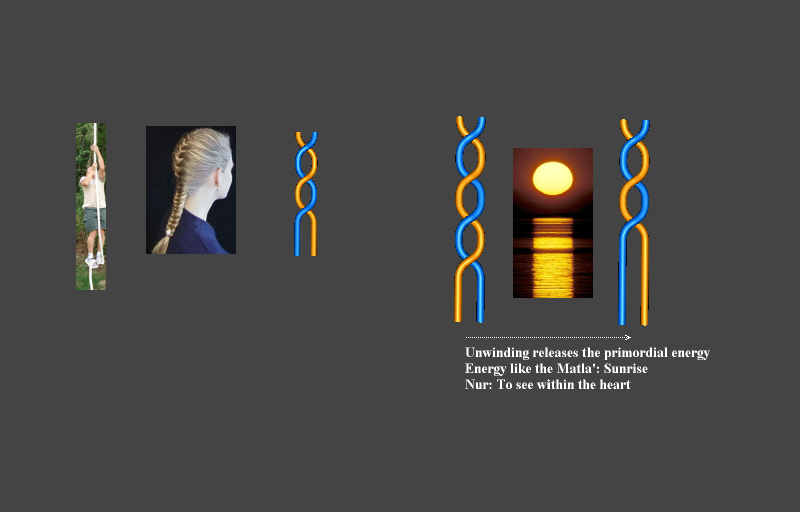
©
2007-2002, Dara O. Shayda, Hind Rifai M.D.






 “[6:103] No
eyes grasp Hu
while Hu grasps/prehends
all eyes” forms a braid through
its topology. Or you might say the Basira, the energy that fuels the
prehensions
within the heart and enables them to see spiritually, is
stored infinitely and indefinitely within the powerful twists and
tangles of the braids:
“[6:103] No
eyes grasp Hu
while Hu grasps/prehends
all eyes” forms a braid through
its topology. Or you might say the Basira, the energy that fuels the
prehensions
within the heart and enables them to see spiritually, is
stored infinitely and indefinitely within the powerful twists and
tangles of the braids:






